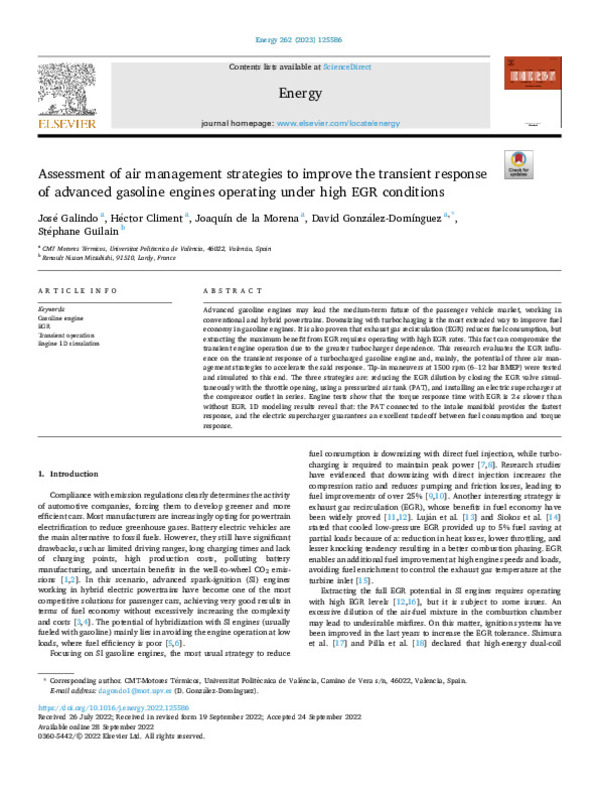JavaScript is disabled for your browser. Some features of this site may not work without it.
Buscar en RiuNet
Listar
Mi cuenta
Estadísticas
Ayuda RiuNet
Admin. UPV
Assessment of air management strategies to improve the transient response of advanced gasoline engines operating under high EGR conditions
Mostrar el registro sencillo del ítem
Ficheros en el ítem
| dc.contributor.author | Galindo, José
|
es_ES |
| dc.contributor.author | Climent, H.
|
es_ES |
| dc.contributor.author | De La Morena, Joaquín
|
es_ES |
| dc.contributor.author | González-Domínguez, David
|
es_ES |
| dc.contributor.author | Guilain, Stéphane
|
es_ES |
| dc.date.accessioned | 2024-04-11T07:38:01Z | |
| dc.date.available | 2024-04-11T07:38:01Z | |
| dc.date.issued | 2023-01-01 | es_ES |
| dc.identifier.issn | 0360-5442 | es_ES |
| dc.identifier.uri | http://hdl.handle.net/10251/203311 | |
| dc.description.abstract | [EN] Advanced gasoline engines may lead the medium-term future of the passenger vehicle market, working in conventional and hybrid powertrains. Downsizing with turbocharging is the most extended way to improve fuel economy in gasoline engines. It is also proven that exhaust gas recirculation (EGR) reduces fuel consumption, but extracting the maximum benefit from EGR requires operating with high EGR rates. This fact can compromise the transient engine operation due to the greater turbocharger dependence. This research evaluates the EGR influence on the transient response of a turbocharged gasoline engine and, mainly, the potential of three air management strategies to accelerate the said response. Tip-in maneuvers at 1500 rpm (6-12 bar BMEP) were tested and simulated to this end. The three strategies are: reducing the EGR dilution by closing the EGR valve simultaneously with the throttle opening, using a pressurized air tank (PAT), and installing an electric supercharger at the compressor outlet in series. Engine tests show that the torque response time with EGR is 2-s slower than without EGR. 1D modeling results reveal that: the PAT connected to the intake manifold provides the fastest response, and the electric supercharger guarantees an excellent tradeoff between fuel consumption and torque response. | es_ES |
| dc.language | Inglés | es_ES |
| dc.publisher | Elsevier | es_ES |
| dc.relation.ispartof | Energy | es_ES |
| dc.rights | Reconocimiento - No comercial (by-nc) | es_ES |
| dc.subject | Gasoline engine | es_ES |
| dc.subject | EGR | es_ES |
| dc.subject | Transient operation | es_ES |
| dc.subject | Engine 1D simulation | es_ES |
| dc.subject.classification | MAQUINAS Y MOTORES TERMICOS | es_ES |
| dc.title | Assessment of air management strategies to improve the transient response of advanced gasoline engines operating under high EGR conditions | es_ES |
| dc.type | Artículo | es_ES |
| dc.identifier.doi | 10.1016/j.energy.2022.125586 | es_ES |
| dc.rights.accessRights | Abierto | es_ES |
| dc.contributor.affiliation | Universitat Politècnica de València. Escuela Técnica Superior de Ingeniería del Diseño - Escola Tècnica Superior d'Enginyeria del Disseny | es_ES |
| dc.description.bibliographicCitation | Galindo, J.; Climent, H.; De La Morena, J.; González-Domínguez, D.; Guilain, S. (2023). Assessment of air management strategies to improve the transient response of advanced gasoline engines operating under high EGR conditions. Energy. 262. https://doi.org/10.1016/j.energy.2022.125586 | es_ES |
| dc.description.accrualMethod | S | es_ES |
| dc.relation.publisherversion | https://doi.org/10.1016/j.energy.2022.125586 | es_ES |
| dc.type.version | info:eu-repo/semantics/publishedVersion | es_ES |
| dc.description.volume | 262 | es_ES |
| dc.relation.pasarela | S\473231 | es_ES |
| dc.contributor.funder | Universitat Politècnica de València | es_ES |
| dc.subject.ods | 13.- Tomar medidas urgentes para combatir el cambio climático y sus efectos | es_ES |








